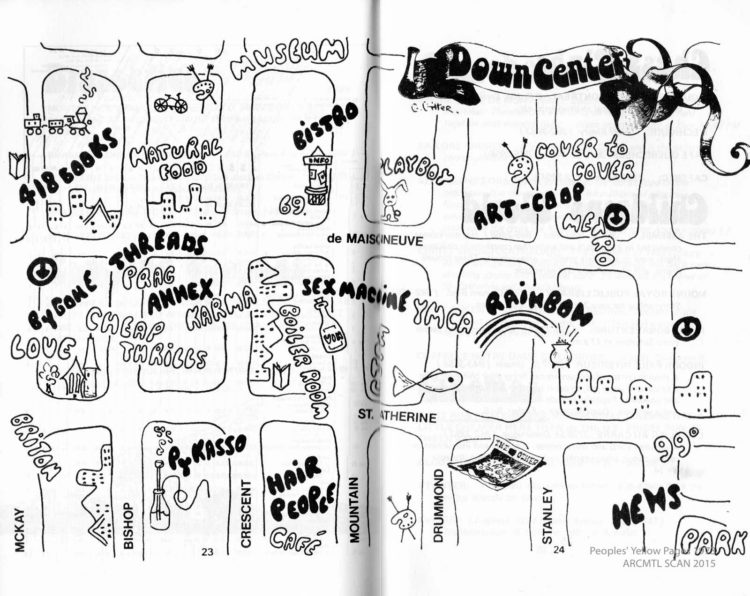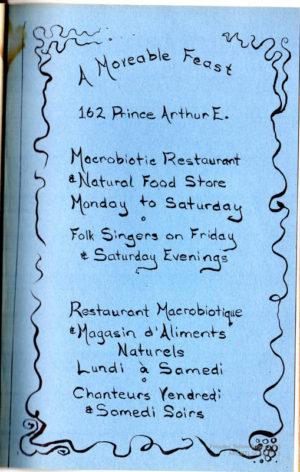Garth Gilker and Montreal’s Peoples’ Yellow Pages
The Peoples’ Yellow Pages, an unabashed guide to Montreal for those interested in alternative and underground lifestyles was published annually from the early to mid 1970s in Montreal. Louis Rastelli interviewed its editor, Garth Gilker, at his Café Santropol in October 2015. This Plateau Mont-Royal institution, begun shortly after Gilker ceased publishing the Peoples’ Yellow Pages, celebrated its 40th anniversary in the summer of 2016.
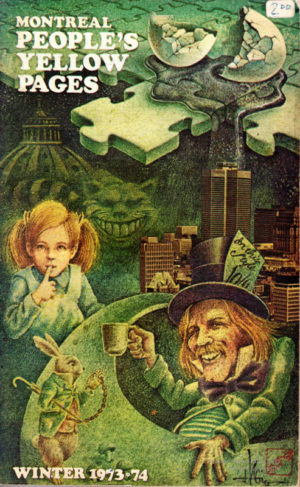
Gilker, also known for his long acting career, recounted his early years in the city and how he went about cataloguing the city’s alternative side as it blossomed between the summers of Expo 67 and the 1976 Olympics. Full issues of the Peoples’ Yellow Pages as scanned by ARCMTL in 2015 are available here on this site.
GG: I’m a Gaspesian from New Carlisle, same town as René Lévesque, but he was much older than me, more like my father’s age. My parents knew him, and I still have a cottage there on the same street that his house was on. My whole family, my parents and the 6 kids all moved here, so that we could live at home and afford to go to university. We ended up in St-Lambert. My father was a livestock inspector, and the abattoir was down on Bridge Street, just where the Costco now is on Bridge & Mill, which was a short drive to the Victoria Bridge, which is why we ended up in St-Lambert. This was in the early ‘60s– there were 10 of us, because 2 of my brothers friend’s came up with them to help. We all lived in one apartment, a 5 ½… 10 of us and one dog. I now live in a 5½ by myself (laughs). I’m fortunate to have all of that space to myself; trust me, I still appreciate it.
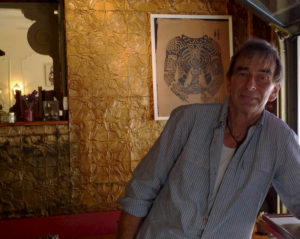
Garth Gilker at the café he opened in 1976 (and still operates), Santropol. Photo by Louis Rastelli.
LR: Did you go to high school in St-Lambert?
GG: Yup, but later we moved to the town of Le Moyne, which is now part of Longueuil. That town was only about 5 streets wide and 4 blocks long (laughs).
LR: When did you start going downtown?
GG: Expo 67 is when I started coming in to the city more often, as a teenager. I worked at Expo from ’67 to ’69.
LR: Did you see any of the musical acts or concerts at Expo 67 or Man And His World?
GG: I pretty much just worked while I was there. I was a taxi driver on the site, in a golf cart. I ended up contracting out to restaurants, so when tourist asked me where to eat, I had already lined up a number of restaurants that would give me free meals if I brought in customers. Then later, I had a group of taxi drivers doing this. There used to be a clock with a little flag on it that looked like a meter, but people didn’t know it wasn’t a meter. We had all sorts of scams going on. At one point Mayor Drapeau had every one of us arrested, we went to the jail for x-number of hours– yes there was a jail at Expo! Us Expo taxi drivers were so out-of-control! (laughs). That was in ’68. In ’67 I was the dispatcher for all of the La Balades, the trains that drove people around. I would keep track of how many people were coming through the different entrances and I would send La Balades out to them. I would also do the night work at re-assembling the Balades trains when they would get damaged or have flat tires, you had the tractor and you always had to have the B and C carriages follow them, you could never put two B’s or two C’s on. So I lived there! My office was across from the American pavilion, my little kiosk, where I was dispatching everything. I would stay there all night… it was like being in a fantasy land, it was wonderful. That’s where I really starting seeing that there was another world out there. Us employees had our own places to eat and shower and stuff.
LR: There were a lot of hostesses too. Was there a lot of camaraderie?
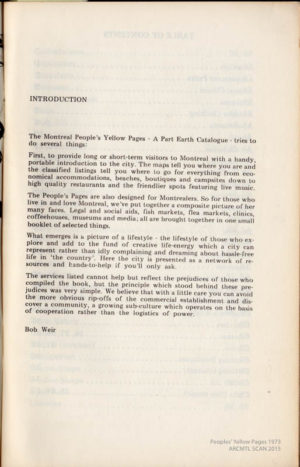
GG: Oh yeah! I remember in ’67, meeting the hostesses from Czechoslovakia and I remember doing the same in ’68, and it was like night & day! Because the revolution had happened in the meantime (Prague Spring). Theirs was one of the most raved about pavilions, they were so proud of their glasswork and their steelwork, the enthusiasm was just bubbling out of all of them. And then in 1968, they were crying, it was like going from a new beginning for their country to the complete opposite. Expo 67 was such a cultural celebration, the Olympics were a complete nightmare, just the opposite, they had nothing to do with culture… The people that visited were only interested in buying ashtrays with Olympic logos on it, whereas at Expo you would have shops selling carvings that they were carving there right on site.
LR: Since you worked at Expo, did you also manage to take-in a lot of the stuff, including the food…
GG: It most likely exposed me to… that there was a world out there, and it was after that, that even I went off to Europe. My father was always into gardening, even though he was a livestock inspector, he should have been a plant pathologist honestly… so I always had an interest in like the gardens and spaces… but it was Expo 67 that taught me that man could duplicate nature in gardening… they couldn’t fill the landscape that they had created, they didn’t have enough pavilions so all the south-side of Ile-Notre-Dame was landscaped and made into miniature lands, like duplications of different landscapes of Canada. Out in the lakes you used to have rocky islands that represented the rocky islands off the coast of Newfoundland and stuff. I remember going out there and was highly impressed with the fact that you could change some because it was all rubble from the Metro and how you could take that rubble and make it into a green-space, that’s where I first saw that! It ended up inspiring me. I ended up digging up the back vacant lot and gardening here (at the Santropol restaurant).
In ’68 I made enough money working in the summer to hitch-hike through Europe for a year! That’s where I got the idea for the People’s Yellow Pages, in Amsterdam.
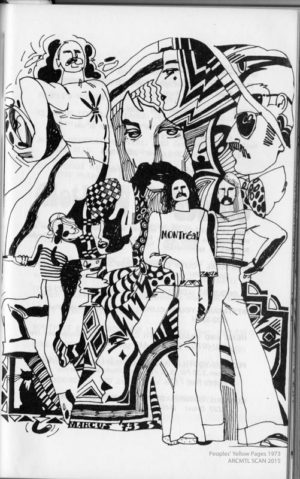 When I came back, my cousin had come up from the Gaspé and was living in a condemned building down on Des Seigneurs just below the tracks in Little Burgundy. It cost $45 a month, which made me realize that I could afford that… I bicycled into this neighbourhood (Plateau Mont-Royal) one summer night and it reminded me of Europe, at that time there was a lot of Greeks here. I had spent over three months in Greece, so I was like “Wow! I’m gonna have to live in this area.” There were a lot of bakeries and places you would never see in St-Lambert, so I got an apartment on Coloniale where everybody usually ended up getting cheap apartments. In fact, I did have to leave in the middle of the night, even though it was cheap back then, I ended up not being able to afford the place at one point.
When I came back, my cousin had come up from the Gaspé and was living in a condemned building down on Des Seigneurs just below the tracks in Little Burgundy. It cost $45 a month, which made me realize that I could afford that… I bicycled into this neighbourhood (Plateau Mont-Royal) one summer night and it reminded me of Europe, at that time there was a lot of Greeks here. I had spent over three months in Greece, so I was like “Wow! I’m gonna have to live in this area.” There were a lot of bakeries and places you would never see in St-Lambert, so I got an apartment on Coloniale where everybody usually ended up getting cheap apartments. In fact, I did have to leave in the middle of the night, even though it was cheap back then, I ended up not being able to afford the place at one point.LR: Did you hang out at any particular places downtown back then?
GG: I knew Rockhead’s, because once my cousin was renting in Little Burgundy, I would come over, we would drink and I would never make it back to the suburbs. The place I remember the most was The Love on Guy Street, right across from The Stork Club, it was up on the second floor and was a dance place. But that was more in the early ‘70s. The Stork Club was a beautiful place inside before somebody turned it into more of a contemporary bar… Even the tables were illuminated from underneath with storks engraved into the glass. It was really a nice old place, of the old-school, old-style bars.
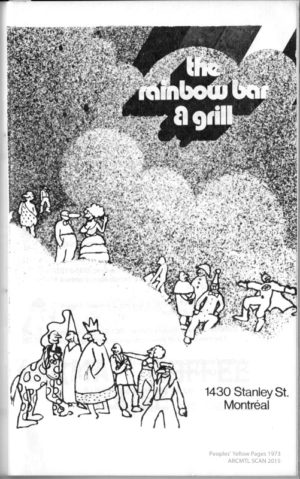
LR: How long did you work at the Rainbow Bar & Grill?
GG: Well, I didn’t last very long… but long enough to collect unemployment. Back then, it was 9 weeks and then I could get unemployment all winter and then I could write this People’s Yellow Pages.
LR: Did the Rainbow have live music at the time?
GG: Yes, plus they had films, so not only did I wash dishes, I was the projectionist as well. So when I left there to get unemployment insurance, I didn’t say that I was the dishwasher—I said I was a projectionist!! (laughs)
LR: Do you remember any of the local films that might have played there?
GG: No.
LR: Was it retro, vintage stuff?
GG: Yeah.
LR: Do you remember any of the artists that played there?
GG: There was April Wine, and Penny Lang, Bruce Cockburn—he played there a lot. It was a small venue in the back. It was one of the first kinda bars that was not a tavern and had more of a contemporary feel. I remember when the Esquire ceased to be The Esquire, they had hardwood floors and the dancefloor was the size of a skating rink, you could fling yourself across the floor for miles.
LR: Did you used to go down to artist-run centres like Véhicule Art or Powerhouse Gallery?
GG: Yeah, I would go to the Véhicule Art, at times to get stuff printed there but also for readings and events. And Powerhouse was over in the church there near Guibeault & St-Dominique. It was all very central. I remember living on Coloniale just below Pine Avenue, and finding it rather far to walk up to the health food store on Duluth Street. In those days, nobody was living up in Mile-End.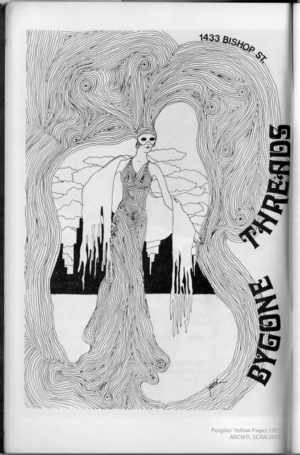
LR: Thing really were more centred around Sir George & McGill, St-Antoine to Sherbrooke…
GG: If I wanted to have a beer in this neighbourhood, I would have to go down to Jean’s on the corner of St-Dominique and Prince-Arthur, it was kind of a tavern. Or down to the Swiss Hut on Sherbrooke and Bleury, and then it became the Chambre Noir across the street, or you’d go over to Mountain or Crescent…
LR: Not one bar on St-Laurent?
GG: There was nothing here… there was the Balmoral Tavern on the corner of St-Cuthbert & St-Laurent, that was about it.
When I decided to write the Peoples’ Yellow Pages, I would bicycle around this neighbourhood and collect business cards, and I would write down all the different alternative places. That’s when Prince Arthur Street was just starting up with Bill’s Leather shop and the Moveable Feast. Even on St-Denis, the only place was a chess club just below Cherrier on the east-side across from Harry’s 24-hour restaurant facing Carré St-Louis. If you look at the maps in the Peoples’ Yellow Pages, you notice that it’s all concentrated in a small area, the Plateau. The very first—what I would call health food store, where you would go in and volunteer and everything was in bulk, was just here on Duluth Street just up from St-Laurent. And the Moveable Feast must have been one of the first vegetarian restaurants in Montreal.
LR: For the first issue, you mention being inspired in Amsterdam but you didn’t mention what publications you saw there. Was it in the Red Light district?
GG: I think it might have been called the Amsterdam Yellow Pages, and there was also one from San Francisco too, the Whole Earth Catalogue was coming out at the same time as well. You could tell that they were printed in small runs, that’s what gave me the idea, I knew that I could do that too. So I dropped out of University and I decided I was going to do Montreal’s People’s Yellow Pages.
LR: I like how the Peoples’ Yellow Pages has a mix of nightlife and fun stuff, but also important resources like health clinics that provide abortions…
GG: And the price of marijuana & hashish, which back then, nobody was printing that information.
LR: Was that why there’s a certain anonymity to it, and why there’s a P.O. Box…
GG: Yeah, that’s station “G” –That was at Clark & Pine Avenue in that building on the southwest corner. That was our post office, then it became a bar, I think it might have been called Secrets or something.
LR: It was considered safe at the time, a post-office box… What sort of research team did you assemble to make sure, for example, that you got all the marijuana prices right…
GG: Me! I did all the research. (smiles)
LR: There was a very similar one we found called Montreal Insolite in French. It has a remarkable overlap with yours, but they don’t really include community resources, they go into some detail as to where there are still whorehouses, where the gay bars are, the straight ones, and the ones that are mixed.
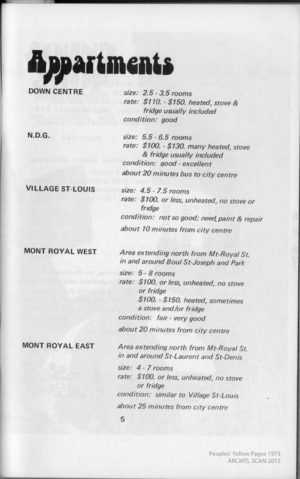
GG: You know something? There was precious little of any of that stuff in Montreal. When I said that there was very few, there was really really really not a lot happening at that time. Montreal—I think in the ’30 & the ‘40s—it was everywhere, but by this time it was pretty dried-out.
LR: I spoke to the guy that did Logos and in ’68-’69 they were printing 25000 copies, but then I get the sense that by ’69-’70 there was a petering-out of the ‘60s scene and a bit of a dead period…
GG: Yes. At that time, in the late 60s, there were not a lot of alternative businesses. I would almost say that most of them were started by draft-dodgers a bit later, that’s when another whole new scene started.
LR: The Prag is one thing that held on though, I think they opened up the mid-‘60s…
GG: Yes, I remember the Prag and sometimes if they had a good, nice ad I would just give them a full page.
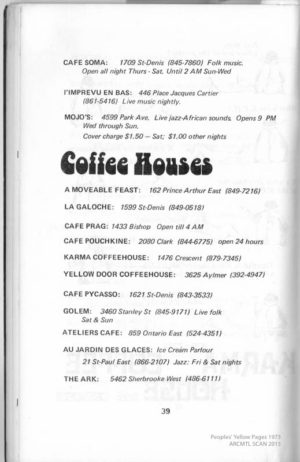
LR: Cheap Thrills is one of the first—It’s still there…
GG: Cheap Thrills goes back forever!
LR: And Guy Lavoie (manager of Cheap Thrills) also goes back to the first press at Véhicule…
GG: I know that and this issue of PYP (leprechaun cover) was also printed at Véhicule Press, because Hijack Press and the guys who worked there, ended working as a printer over at Véhicule.
This (yellow cover) is the very first version of Peoples’ Yellow Pages because it has no name… I didn’t know what to call it– “Yo!” ?? — and that’s why there’s two names inside. I might give credit there to Hijack Press, they published the first two editions. They were in the IATA building on University Street — IATA didn’t know of its existence. It was operated by the night shift; I would go in to this huge printing room with tons of printers and tons of paper and nobody else there. We ended up printing it on their paper, printing & stapling it on their machines. Any mistakes we would make, we’d bury them deep in the bottom of these big barrels of waste paper left by the day shift. I remember the night that we took the first issue out, we put the boxes on a couple of big dollies, down the elevator, out the front door and into a borrowed truck so fast that the security guard didn’t even move. They didn’t even know what was happening — nobody expected it, we just high-tailed it outta that that place! (laughs) The next day, new rules & regulations were in place at IATA, because they never ever found out what was taken out of the place! (laughs) It was called Hijack Press because of course IATA was the International Aviation Transport Association of the United Nations…
So that’s how the first one came, then all of a sudden a newspaper caught wind of it and wrote about it. We only printed up about 500… and now almost a full-page write-up in the newspaper… we could sell thousands!! But we didn’t have thousands. If we had had the money, we would have done it with a bigger run, and would have made more money…
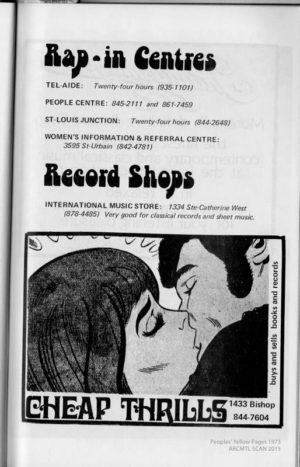
LR: And then the next one, which is the most common one I’ve seen…
GG: The one with the cross on the cover was done on the South Shore, because of the binding and everything.
LR: Was that Payette & Simms perchance?
GG: Yes.
LR: How many did you print of that one?
GG: Almost five thousand I think. That was a pretty good run in Canada back then. I remember one edition I was working on it for quite some time, I went up to CHOM and the guy was on the air, I just handed it to him and he said: “Oh! We heard that this was in production” and asked where it was being sold at. So I said: “All the alternative places like Labyrinth,” and I said to him: “Don’t mention Classics [the bookstore chain]”. I had gone into Classics and asked them if they wanted to carry it, and they had refused to. I get into the car afterwards and on the radio he’s saying: “It’s available at Classics” (laughs)! So the next day I went into Classics and they say: “We’ve been inundated with telephone calls about this book at our store in Town of Mount-Royal in the Rockland Shopping Centre.” So I said: “Would you like to take the book?” and this time they did.
LR: Classics is the one that became Coles and then Chapters, right?
GG: Yeah, and they had the one big bookstore on Ste-Catherine Street near Crescent at the time. A big plus was they classified as an information-travelers kinda guide, which is what I had intended it to be, so it was always at the cashier’s– the best location you could possibly get for a book!
LR: How much did you sell them for?
GG: I based the price on what I could afford, little did I know, I couldn’t afford to exist! Even the café when it first opened… I was selling fresh orange juice for 80 cents a glass and it was costing me at the time $1.10 to make, and I thought 80 cents was so much money that I was lucky to get it. I didn’t even think of calculating the cost. Once the costs were calculated, I was sitting there saying: “What the Hell!?” No, no—the price was just arbitrary, it was what I thought I could afford. Did I make money? No!
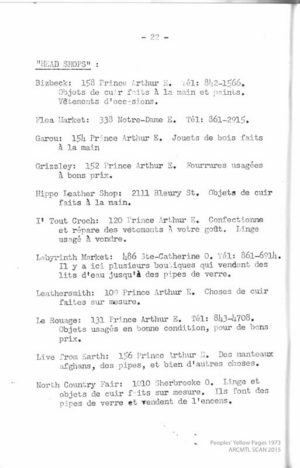
LR: But the printing—even when you paid for it later—I’m assuming it was fairly cheap.
GG: I can’t remember that. I do still have all the printer’s plates, not the metal plates, the paper plates that I did with print glue and t-square. I would go down to Véhicule Press to have everything printed up. To check for spelling mistakes, I would have to take my X-acto knife and cut out each word and then replace it in the script. That means that if there was a mistake half-way through, I would have to cut and move everything around to get a flowing paragraph and then I would line it up … that’s how I did every one of them!
And the girl who did the maps and some of the drawings—Cynthia, I think her name was. She was the waitress at Mazurka’s. I used to spend time there having chicken-noodle soup with bread from Rose’s Bakery—they made the best rye bread in the world!—and that was down on St-Dominique, above Sherbrooke—and she would give me all the bread I could eat, and that’s what I could afford. We were chatting one time—because she was always my waitress—and she said she did illustration. So she did all the illustrating in the last edition.
LR: I presume that partly why there were no other editions was that you got too busy opening Café Santropol.
GG: That’s right. In fact when I was opening the café, I was so involved in renovating and getting things ready that somebody said to me: “What kinda food are you gonna serve?” and I hadn’t even thought of it. I was gonna open in a week, what am I gonna serve? I jumped on my bike and went to the Moveable Feast, which was named after Hemingway, and that was a vegetarian café-restaurant that had alternative books at the front. So I walked in and said: “Do you have any cook books?” and there was a reprint of a depression-era sandwich book that appealed to me. I took it out and looked at it, and said OK fine, this is what the menu’s gonna be. That night I went through the book and chose different sandwiches and that’s how the sandwiches got here! I still have that book!
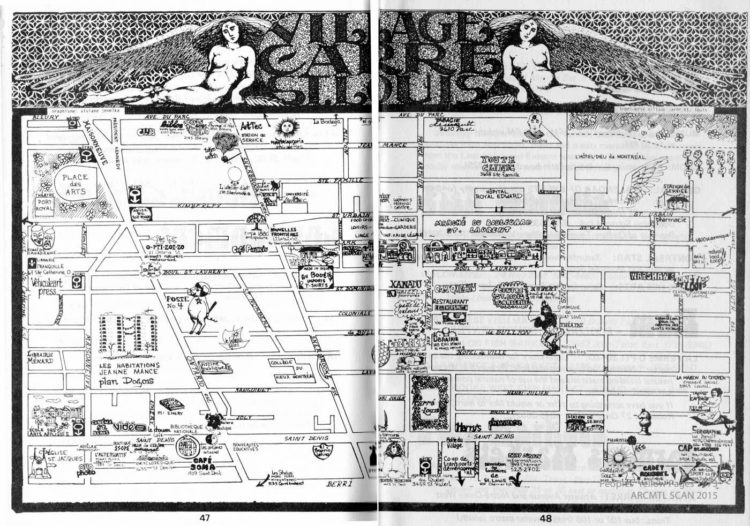
I remember also going down to Stash’s, he had the café in Old Montreal, it was a Polish restaurant and he had also opened up the flea market near there. And he told me, as far as the permits go: “What you do is just get a hotplate: it’s a loophole! I take all my Polish sausages and just boil them up in the hot-plate, I make my borscht on a hot-plate and you don’t have to get all those expensive, overhanging vents and fire extinguishers and all that stuff,” which none of us could afford. So obviously, I was never gonna do French fries, or seriously cooked food, because the hot plate was the simplest thing and that’s why sandwiches came in.
I opened Santropol in ’76 on St-Jean-Baptiste Day. I finished renovating it with the money that I got from the big concert that day. It was the first year they had the big celebrations on the mountain—there were so many people there, I made money selling sandwiches to people coming or going to the concert, closed it down the day after, finished the renovation and opened again on July 4th. René Lévesque came to power in October of that year, and everybody was leaving Montreal, and I’m sitting there saying: “I must be the only English-speaking person opening a business while the rest are running away!” (laughs) I kinda figured, ”Well, they guy is from the same town that I was from, so why not just stick around!”
LR: It kept the rent cheap!
GG: Yeah! When I first rented this place, the front section was $50 a month. Even at that, it was a stretch to pay the rent, because of the tough times. But nowadays it’s really hard to open a small business. When I first opened Santropol, I couldn’t wait. Judy, one of the owners at the Rainbow Bar & Grill where I had worked, said to me: “Make sure you get a list of all the things that they (the inspectors) want you to do.” I got that list; they don’t want to give you that list but I got it, and I did everything that was on it. Then the inspector comes in and says to me: “Well, where’s your grease filter?”
I said: “Grease filter?”
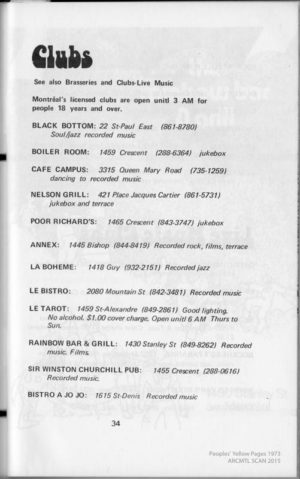
He said: “For under your sink for grease and oil and stuff.”
I said: “I’m not cooking anything!”
“Well, aren’t you gonna have French fries?”
I said: “No way, I’m never gonna have French fries. I was born in a restaurant that introduced the french fries and hamburgers and hot dogs to the Gaspesiens, I went to school smelling like that, like a French fry constantly, and the French fry machine caught the house on fire every three nights and my parents would come and wake us up and say the business is on fire”… we lived behind the restaurant.
But the inspectors couldn’t believe me. Back then, there were pizzerias, high-end restaurants, hot dog & hamburger joints, and nothing else! They just assumed that we were gonna sell soft-drinks, French fries and hot dogs and you’d have to have a grease stove, and I said: “No, no, no.”
Eventually he got me though, for not having a Dixie-cup dispenser in the bathroom, and I went to court. When the judge asked me, I said: “Listen, I did everything that I was supposed to do on the list.” The thing that they never asked me was, do you have a permit to be open? And I didn’t!! I was opened for 4 months before I got a permit because I couldn’t wait any longer, and I looked at the judge and I said: “I opened about 4 months ago and now I’m here on a Dixie-cup dispenser charge.” He slammed his gavel down and said: “You got your permit!” So I got my permit in court for this place. The café only opened up at about 4:30 in the afternoon and closed at like 4 or 5 o’clock in the morning. So when the inspector was going home, we would be opening and when he was going into work, we were closing. I’m sure they came by wondering, “what is this place? Because it’s never open!” Not when they were around!
Gilker still owns and operates Café Santropol while maintaining a relationship with its well-known spin-offs, the Santropol fair-trade coffee brand and the Santropol Roulant meals-on-wheels non-profit service organization.
